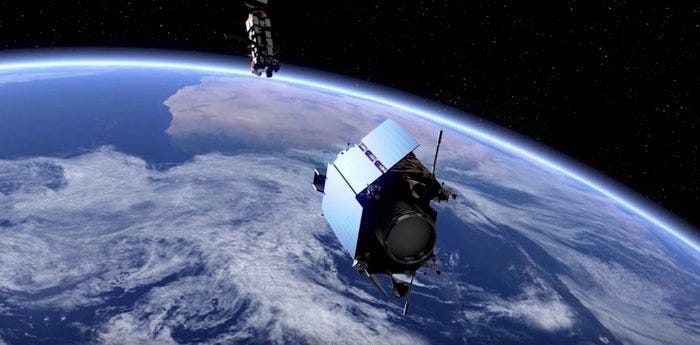The Perils of Space Debris: Are We Bound to Earth Indefinitely?
Written on
Understanding Space Junk
Currently, there are approximately 6,000 satellites in orbit around Earth, with over half of them classified as debris.

Imagine living in a quaint town, longing to discover what lies beyond its borders. However, warnings abound about a dangerous expanse outside the town, filled with tiny, swirling fragments of metal and glass. This menacing vortex serves as a barrier, preventing anyone from leaving or entering, thus confining the inhabitants to their familiar surroundings.
For the residents, the mysteries of the world beyond remain unknown, just as humanity's understanding of space is threatened by the very debris we’ve left behind. But how does this metaphor connect to the reality of space junk?
What Constitutes Space Junk?
Among the 6,000 satellites orbiting our planet, around 2,800 are actively functioning. These include approximately 1,400 commercial satellites, which facilitate GPS and internet services. Additionally, about 350 satellites serve military purposes, predominantly controlled by the United States. Furthermore, there are 133 civil satellites responsible for environmental monitoring, alongside around 100 multipurpose satellites.
This leaves a staggering 3,200 satellites that fall into the category of "space junk," which encompasses those that are non-operational or have outlived their usefulness.
So, how did these satellites come to inhabit our orbit? A significant portion—75%—originated from just five countries, many launched during the initial space race. The US has deployed a total of 1,800 satellites, while China trails with 412 launches. Yet, the race for space continues unabated. In just the past decade, around 2,500 satellites have been sent into orbit, and estimates suggest that up to 10,000 new satellites could be launched in the next ten years.
The Future of Satellite Launches
Launching satellites is no trivial expense. Four decades ago, NASA's shuttle launches cost an astronomical $85,216 per kilogram. However, technological advancements have dramatically reduced these costs. By 2006, the price per kilogram had dropped to $9,930 with SpaceX's Falcon shuttle. Fast forward to 2016, and that cost plummeted to just $1,891 with the Atlas 5 rocket. The introduction of the Falcon Heavy in 2020 further decreased launch costs to below $1,000 per kilogram.
This significant reduction has made satellite launches accessible to a broader array of countries, companies, and even individuals. For instance, Zimbabwe plans to launch its own satellite by the end of the decade.
Furthermore, satellite construction costs have also diminished. Once, satellites were as large as trucks, costing upwards of $500 million to build. Today, many are the size of microwaves or even smaller, costing as little as $1 million or even less, depending on their function.
This affordability has spurred companies like SpaceX and Amazon to design extensive constellations of satellites, aiming to provide global internet coverage, even in remote areas. Most of these satellites will operate in low Earth orbit, significantly reducing latency compared to older satellites positioned further away.
As predicted by The Verge, we could see around 100,000 satellites in the coming decades, which would revolutionize internet access worldwide, driving social and economic changes. However, this rapid expansion also brings considerable challenges, including the risk of being trapped on Earth indefinitely.
Challenges Posed by Satellites
Satellites reflect sunlight, which might appear inconsequential but poses a significant challenge for astronomers. With thousands of satellites orbiting, observatories are increasingly struggling to make meaningful observations. Moreover, satellite regulation varies by country, complicating the enforcement of rules, particularly concerning constellations owned by private entities.
Additionally, smaller satellites have shorter operational lifespans, which could result in an even greater accumulation of debris in low Earth orbit in the coming years. On average, satellites take about 150 years to deorbit, meaning any malfunctioning units will continue to contribute to space junk for centuries.
If the situation becomes too congested, we could face the Kessler Effect, where a collision between satellites triggers a chain reaction, resulting in millions of fragments floating around Earth and creating an enormous debris field. Such an event would obliterate existing satellites and prevent the launch of new ones, effectively halting human space exploration for an extended period.
The destruction of satellites would disrupt GPS and internet services, potentially transforming low Earth orbit into a hazardous junkyard. This "vortex" of debris would trap humanity on Earth, making any attempts at launch perilous due to the risk of colliding with tiny, high-speed fragments.
While the Kessler Effect is concerning, it's crucial to remember that the new satellites promise tremendous economic and societal advantages, potentially connecting hundreds of millions to online services and sparking a new technological revolution.
However, managing this delicate situation will be vital. Decommissioning old satellites and ensuring their controlled re-entry will be crucial to prevent future collisions. Given the high costs of decommissioning and the lucrative nature of launching new satellites, it remains to be seen whether governments and corporations will take on this responsibility.
The first video titled "The End Of Space Exploration (We Can't Leave)" delves into the potential consequences of our increasing reliance on satellites and the implications for future space travel.
The second video titled "Space Debris" explores the growing issue of space junk and its impact on our ability to explore beyond Earth.